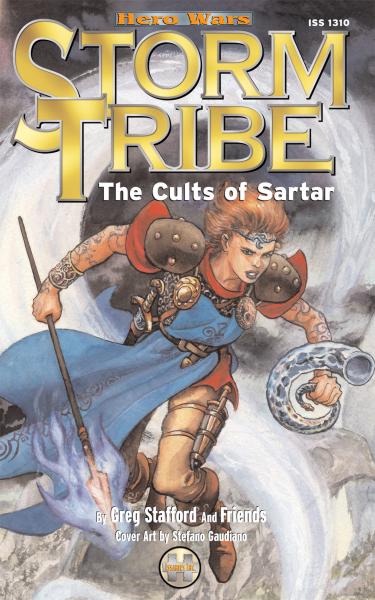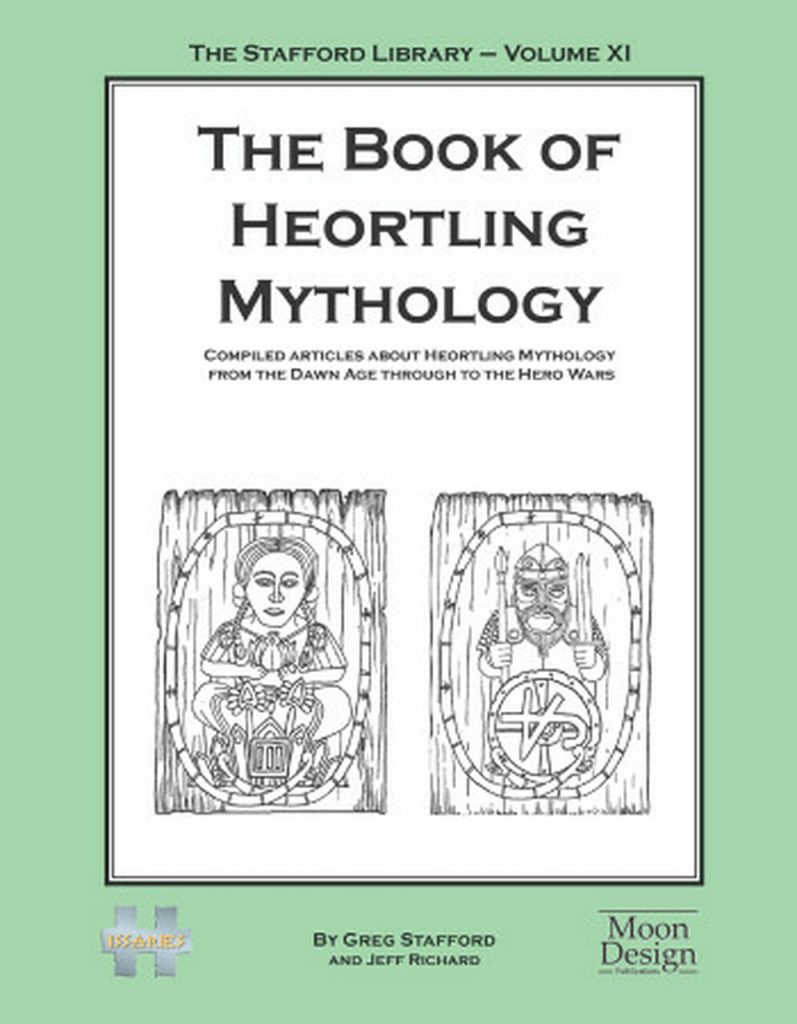Welcome to a new issue of the Journal of Runic Studies, the premier Malkioni publication for studies into the nature of Glorantha. If you haven’t subscribed yet, please consult with the spirit bound to the appropriate electronic page.
God Learner Sorcery
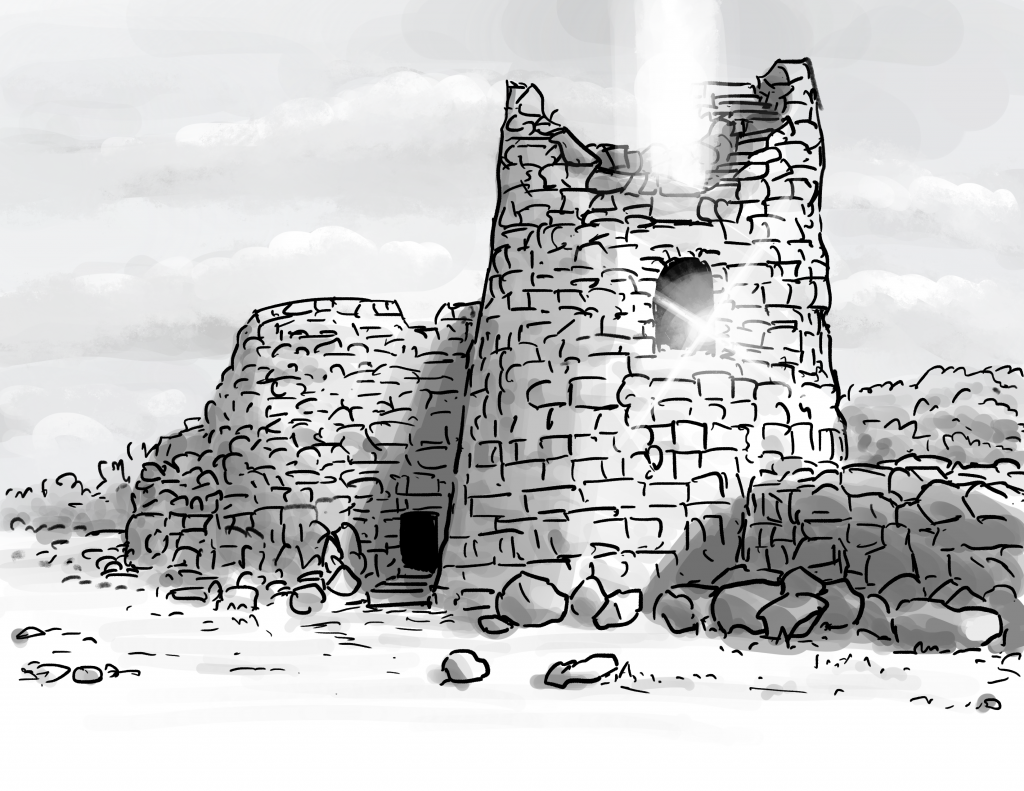
Here is what us God Learners were up to this week.
What Does YGWV Mean?
Since this question was recently highlighted on the Chaosium blog, I wrote this short article about my own take on the venerable acronym.
It’s a good opportunity however to remember what YGWV/YGMV is good for around fan communities. Wayne said it in his interview: it’s good to create a fan culture that embraces different visions of the game and its world, but it can be a tad annoying to see it thrown around any time someone asks a very simple question about the canon. A simple question should get a simple answer.
Read more here.
Chaosium News

Here are this week’s Chaosium news!
Update on the Cults of Glorantha
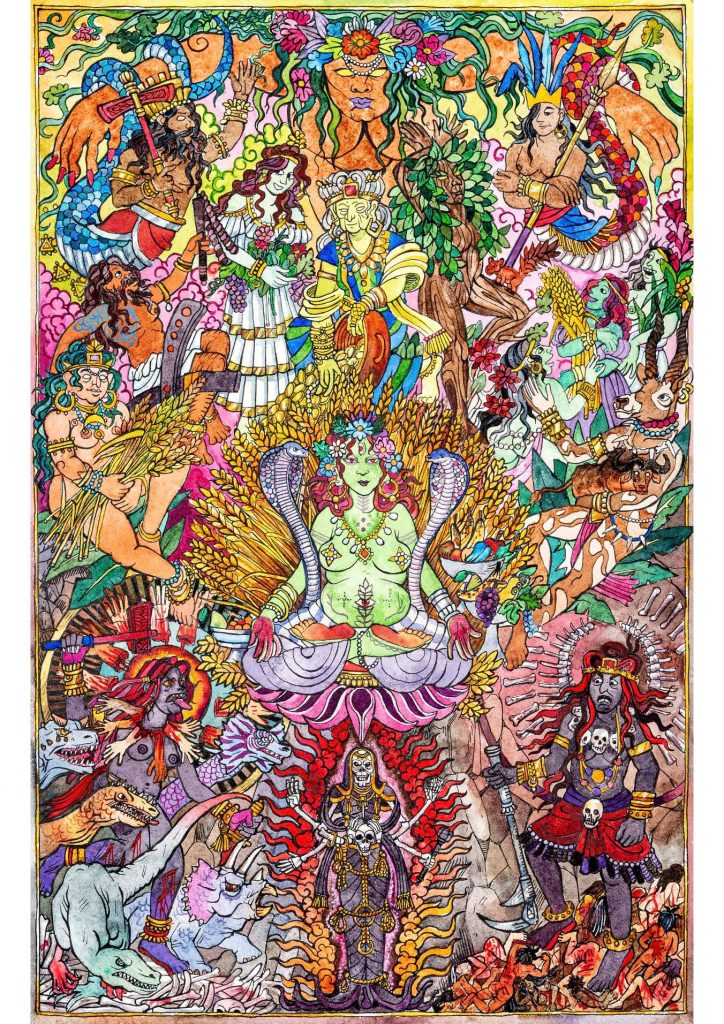
Jeff gave an update on Facebook about this. There are some good news, some extra details, and some bad news.
Good news: with the art all done, the book is currently in layout, with “a few charts and minor elements” still being worked on. Also, Chaosium is finally hiring professional proof-readers to avoid the problems found in most recent RuneQuest books. Apparently, the “community proof-reading” done on the PDFs was “mixed success at best”, which isn’t surprising to me.
Extra details: we have a final count of what’s inside this two-volume monster. “We have 96 distinct cults plus another 40 or so minor cults.” All 96 cults are long-form write-ups similar to those in Cults of Prax and Cults of Terror. The entire project is apparently bigger and more complicated than the Masks of Nyarlathotep slipcase for Call of Cthulhu, which is saying something.
Bad news: Chaosium seems to be moving away from the model of releasing the PDF first, and the physical book second. Instead, they are going for simultaneous releases, just like with the RuneQuest Starter Set. Back in 2018 I would have nodded or shrugged at this. In 2022 however, when a product ready to market doesn’t reach consumers for months because of paper shortages and shipping issues, I don’t know if it’s such a good idea. Obviously the people at Chaosium better know what’s up and how to manage their product pipeline… but what I’m saying is that maybe we won’t see much this year after all.
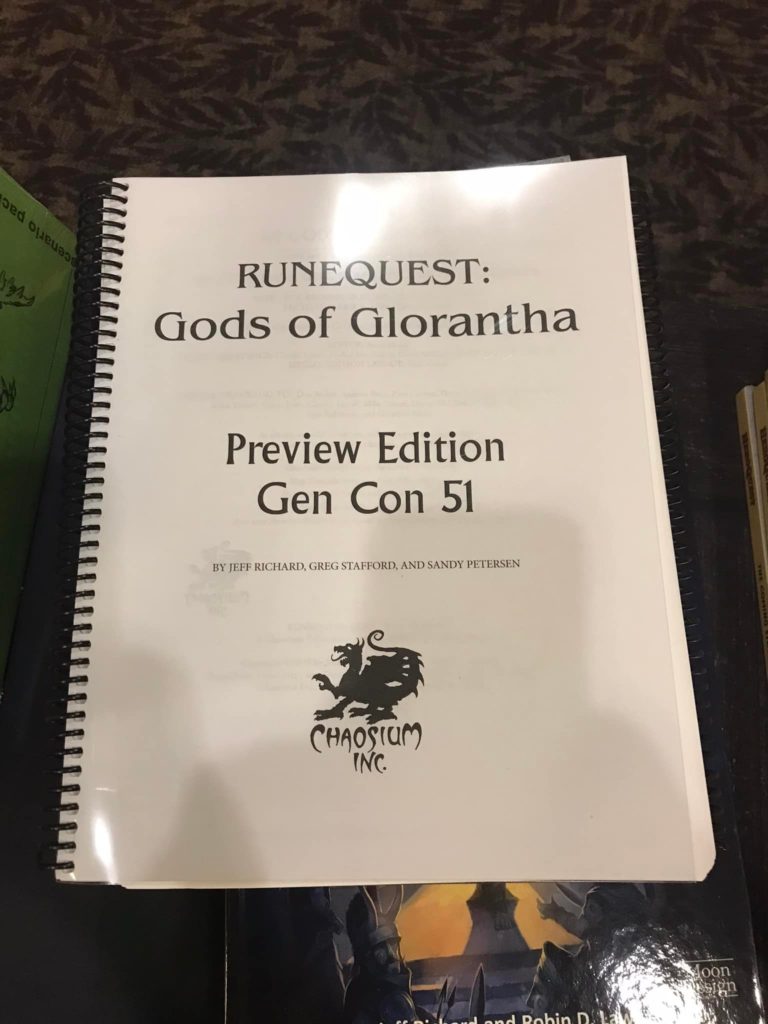
To whet your appetite, you might also want to check back on the Well of Daliath, which now has a list of contents for the GenCon “preview edition” of the Cults of Glorantha from 2018. Things have changed since then, but it might give you a good idea of what’s in there.
Jeff on Real-World Mythology and TTRPGs as Media
This was an interesting video (thank you to James Coquillat for asking good questions!) on the relationship between real-world mythology and Gloranthan mythology. For instance, you’ll hear Jeff talk about how Gloranthan divine archetypes are skewed one way or another compared to ancient world pantheons because of gaming considerations.
Jeff’s remark that there’s too much war magic in Glorantha is good. I’m always sad that combat magic can routinely give big, or even massive, bonuses to combat skills, but non-combat magic tends to give only modest bonuses to non-combat skills… Even if it did, though, I think I still have a lot to figure out in terms of cool ways to involve, say, fertility magic into scenarios, both narratively and mechanically.
This second video isn’t directly related to Glorantha, but it’s got Jeff in it so I might as well put it there too, especially since there are a couple of good points about the difference between RPGs and movies/TV series.
Weapons & Equipment Guide in Print
Hold off your exotic mounts worth worth 400 to 1200L, it’s not quite out yet, but MOB has posted pictures of an advance copy sent by the Polish printer Chaosium is using. Behold, it exists in dead tree version!
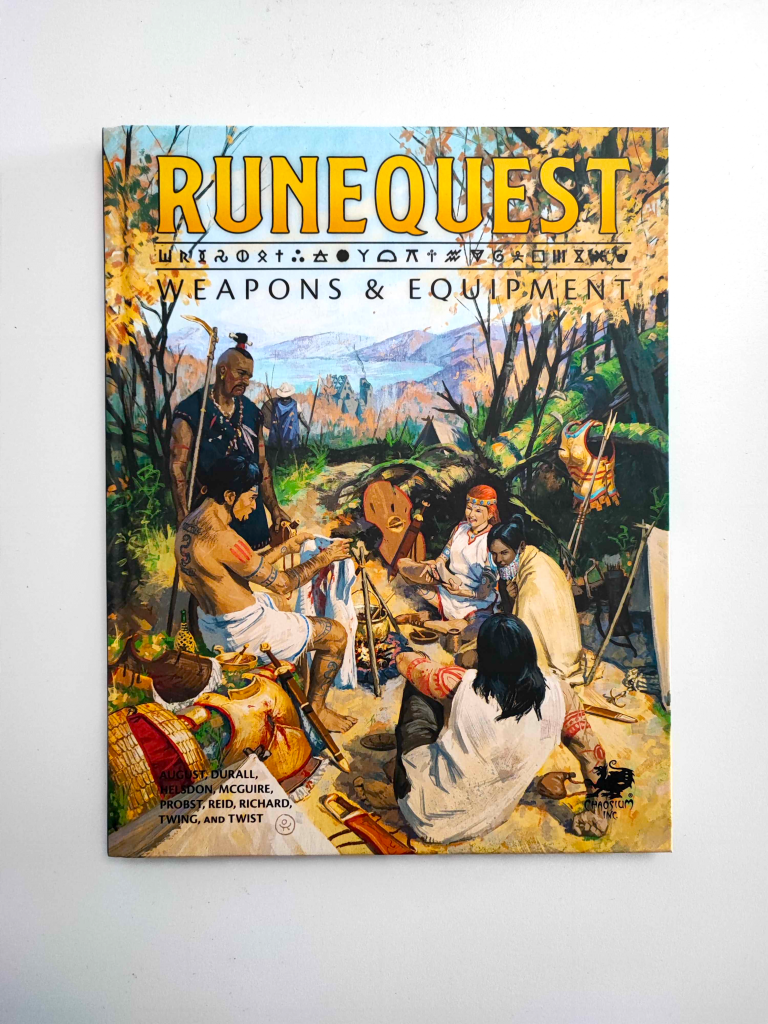
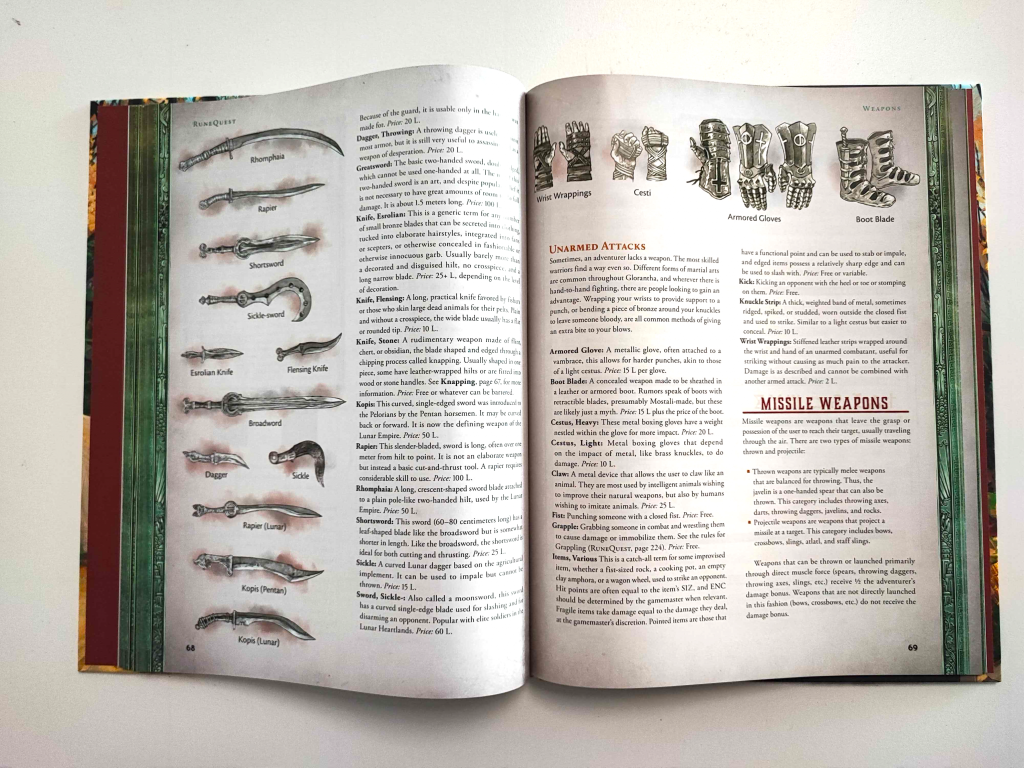
Jonstown Compendium

The Jonstown Compendium is Chaosium’s community content program for all Gloranthan games, hosted on DriveThruRPG. Disclaimer: all the relevant links are affiliate links that hopefully will let us cover some of the hosting and maintenance costs for the website and podcast! Thanks for using them!
Lost in the Dark
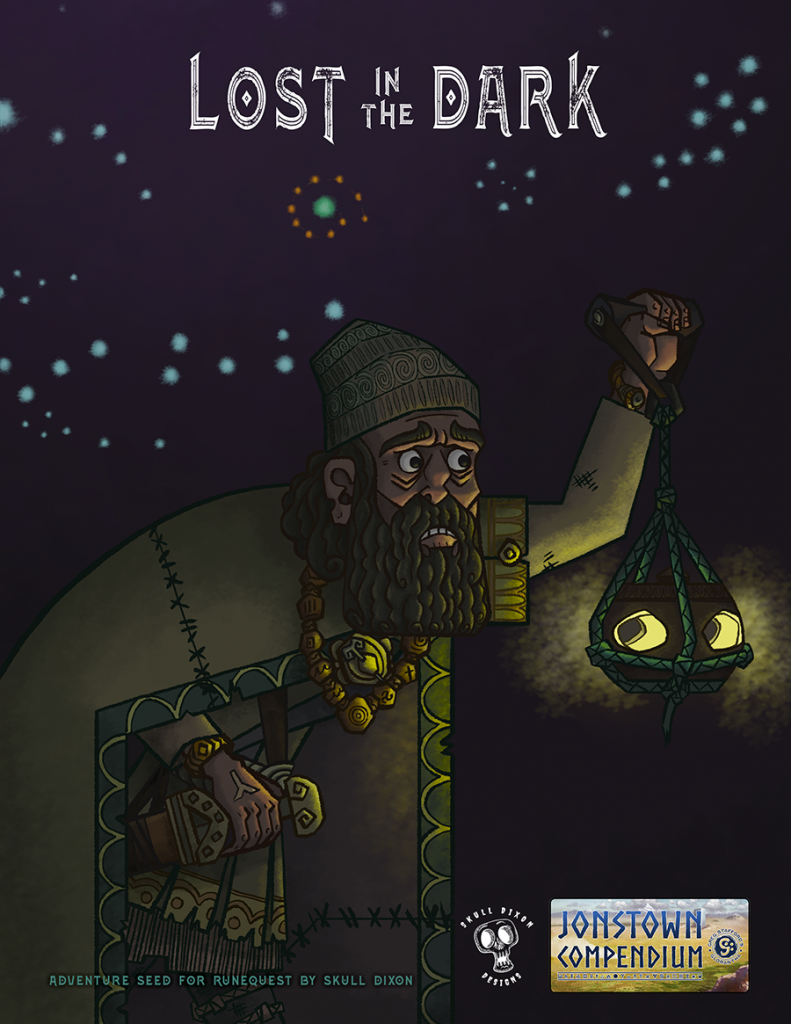
Josh “Skull” Dixon, which we interviewed in our Glorantha Initiation series, has released a short 11 pages adventure called “Lost in the Dark” featuring a new Darkness spirit about… well, being lost. In the dark.
Secrets of Dorastor Update
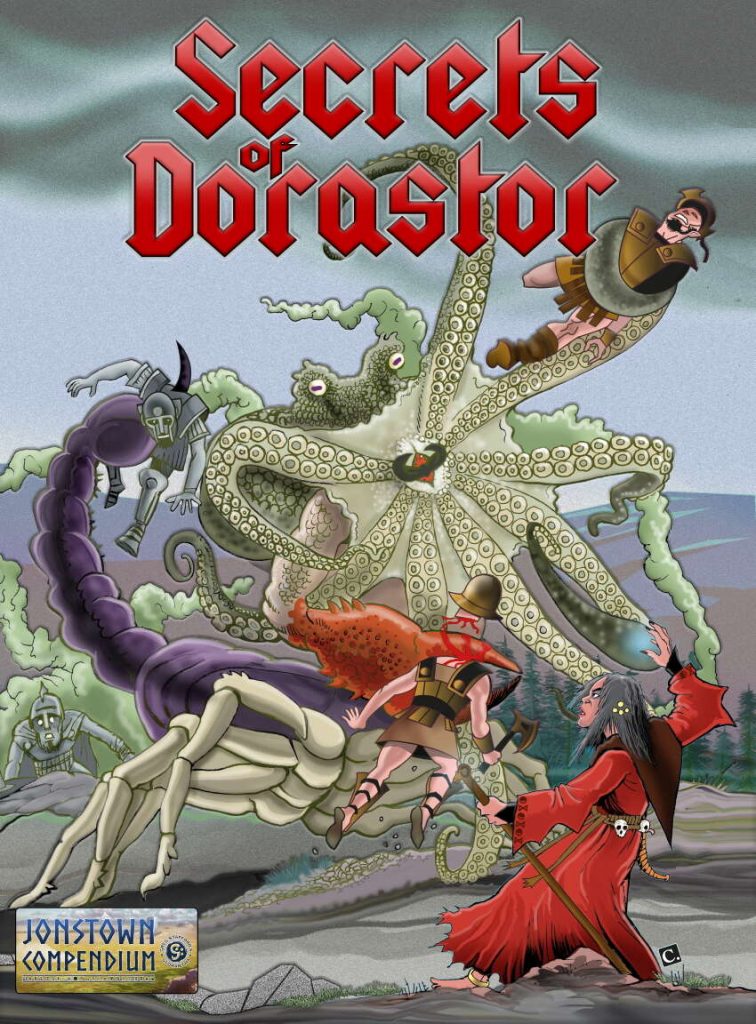
Simon Phipp has updated Secrets of Dorastor with a companion document called “Personalities Tactics”:
It contains nearly 70 pages of notes about High Level Personalities and gaming. In it are:
– Expanded Tactics for all the Personalities from Secrets of Dorastor
– Some suggested tactics that can be used when playing RuneQuest Glorantha
– A quick review of the tactics from the excellent RQ2 RuneMasters supplement, which is recommended reading for anyone wanting to know about RuneQuest Glorantha tactics
– The latest Jonstown Compendium Wall of supplements
If you have already bought Secrets of Dorastor, you should already see this new PDF as a download.
Covers of the Jonstown Compendium
This was posted on the Chaosium blog, but it’s about the Jonstown Compendium so I’m putting there to even out the sections a bit… Various Chaosium people got together to pick covers they like in recent community content items, and I’m happy to report that my cover for Austin Conrad’s “To Hunt a God” was among the selection!

You probably won’t be surprised by the other picks, from Katrin Dirim’s work on The Six Paths to Mark Smylie’s cover of The Armies & Enemies of Dragon Pass.
Jeff’s Notes

Jeff Richard, the current mastermind on everything Gloranthan at Chaosium, is often posting notes and thoughts on the RuneQuest Facebook group. Here’s our curated list from the past week. A partial archive of these sources is compiled on the Well of Daliath.
Prince Saronil Stealing From The Dwarves
Agathe Pitie, whose expansive artwork will be all over the upcoming Cults of Glorantha, is apparently now working on the upcoming Sartar Homeland boxed set (or whatever it will be called). Here is “Prince Saronil stealing secrets from the dwarves”, from the “Illustrated History of Sartar” (whatever that is):
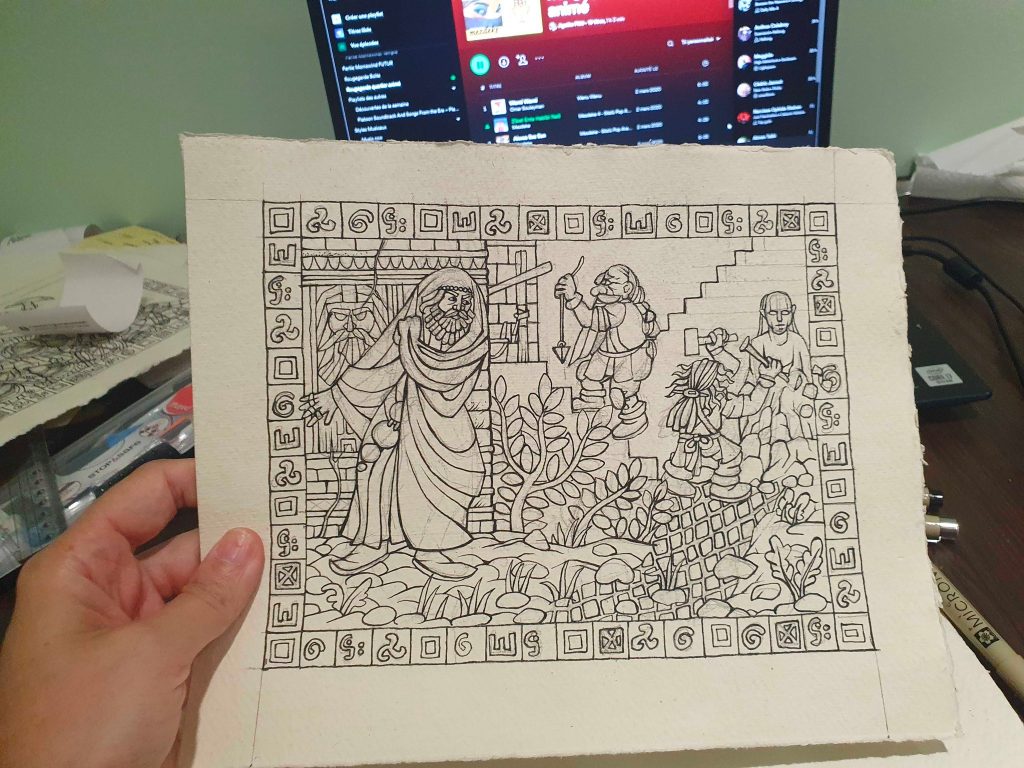
Jeff adds:
I think it is very important to present the history of Sartar visually, particularly for those now entering the game.
Silver Sartarite Coins
Coins featuring various rulers are a big cornerstone of the ancient world, so it was only a matter of time before we saw more Gloranthan material on the topic. But hey, remember that coin of Alexander with the elephant helmet from last week’s Journal? How about something similar but with Sartarite rebel-turned-Prince Kallyr Starbrow instead?
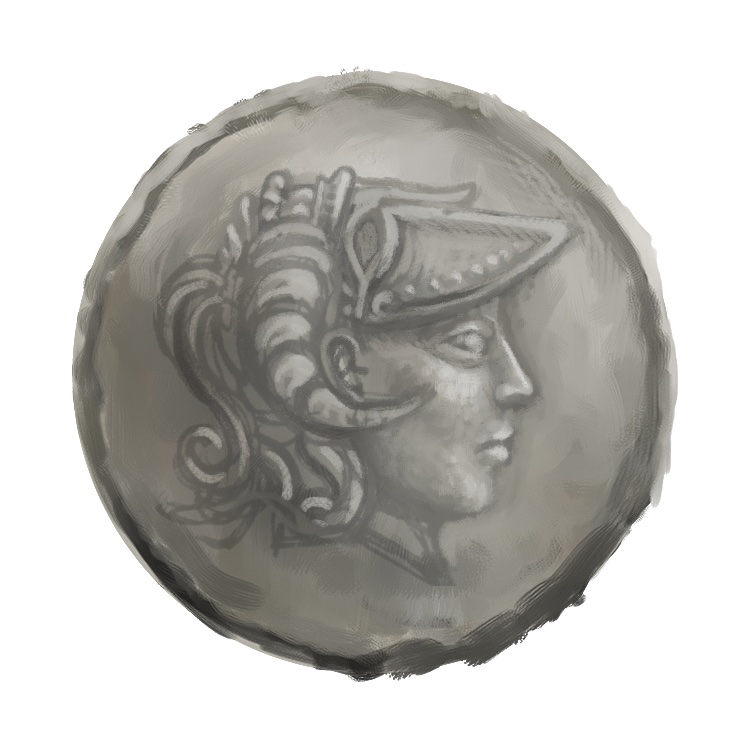
I mean, sure, once you try to emulate ancient Greek or Roman coins, it’s all side-portraits with or without helmets anyway, so not a lot of artistic wiggle room. Here’s another coin featuring Alexander with a similar-placed helmet:
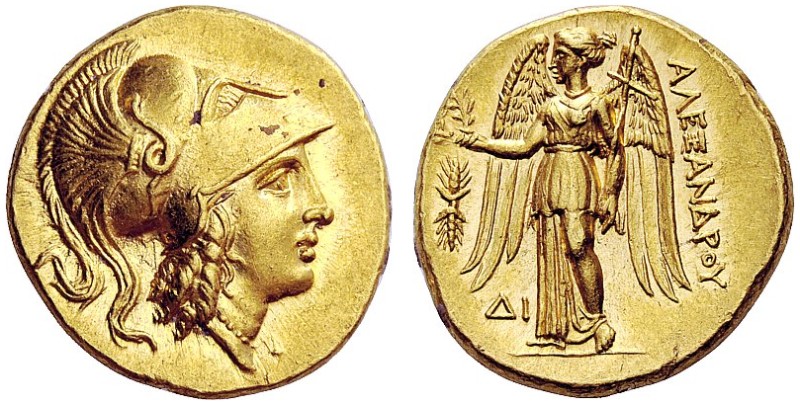
Back in Glorantha, the silver coin depicted above was made during Prince Kallyr’s short reign.
The ram horns are part of the Orlanth Rex inconography and give the Prince quasi-divine status linked with Orlanth. Kallyr’s celestial associations are minimized in this coin, and largely follows the design of previous Sartarite coins.
Silver currency was introduced in the Second Age by the Middle Sea Empire. Sartar enthusiastically issued silver coins during his reign 1492-1520, and his dynasty continued with that.
The Sartarites minted silver Sovereigns, which were replaced by Lunars after 1602.
I believe these coins are also called “Sartarite Guilders”, unless it’s actually another type of coin that I didn’t know about.
One of the first things a new ruler does is have coins minted. It advertises you, legitimises your rule, and let’s everyone know who is in charge.
Do You Want More Elmal/Yelmalio Debates? Of Course You Do!
A thread on BRP Central about what the Yelmalio cult might look like in the Holy Country devolves for a while (of course) into a whole Elmal/Yelmalio explainer once again. But with a few extra bits of behind-the-scenes information on some HeroWars/HeroQuest-era sourcebooks. Strap on to your sun horse!
Again I don’t know why people would expect that the cult of the Little Sun is going to look very different from Yelmalio, regardless of name.
Prior to 1500 or so, the Little Sun cult in Sartar would look a lot like Yelmalio, although possibly with no gifts, no Cloud Clear, and probably no Sunbright. Now that the Little Sun cult is revealed to be Yelmalio, the Yelmalio-as-Orlanth’s Thane cult just swaps out Shield from Yelm with Shield from Orlanth.
You might remember that the general idea is that the Yelmalio cult was strong at the Dawn and during the First Age, since he kinda helped a lot of people during the Great Darkness by keeping the lights on. But the Heortlings had not met any of these people yet, so they just had the arguably weaker Elmal cult.
A guy named Monrogh Lantern eventually does some exploratory heroquesting and finds that Elmal is Yelmalio, and Yelmalio is much more powerful — enough to get the vast majority of Elmal cultists to adopt the new dogma:
No matter how you slice it, the pre-Monrogh Elmal cult had far less magical power and range than the post-Monrogh Yelmalio cult.
This is where we get into game publication archaeology, because the Elmal cult had a few write-ups. Whether Elmal was indeed “weaker” than Yelmalio therefore spills into game mechanics and edition wars.
For instance, in the 2001 HeroWars “Storm Tribe“, Elmal is described as providing magical abilities such as “Blazing Spear”. The 2009 “Book of Heortling Mythology” has stories about Elmal burning some stuff down. Jeff says:
Greg had very little to do with that writeup. And Book of Heortling Mythology was filled with draft ideas from us without any editing. I am sure I have said many times that Greg was ambivalent about publishing that for exactly that reason (same with Arcane Lore).
Remember folks: don’t believe everything you read in the Stafford Library books… they’re just Greg’s unedited notebooks.
In the 2009 and 2012 HeroQuest “Sartar: Kingdom of Heroes“, Elmal lets you shoot fire arrows and summon “lesser Fire gods”, among other things. Jeff replies:
I wrote the S:KoH writeup. In retrospect I got Elmal wrong (and I had serious doubts about it when I was writing it – but at the time I wanted it to link with KoDP).
So let me make it clear – if I was to rerelease S:KoH, I’d change that.
It’s worth noting that anybody who just stuck to RuneQuest and never looked into HeroWars/HeroQuest, or the uncommon system agnostic material, might have been a lot less confused about all this.
Here’s some more behind-the-scenes stuff about the writing of these books:
Mythically it was appropriate to understand the Orlanthi of the Dawn. That was the extent that Greg cared about Elmal. But KoS made it clear that by the Hero Wars Elmal was recognized as the Yelmalio we all know. Greg was working on his Harmast materials, set in the First Age. In fact, from about 1991 to 2012 or so, Greg had very little interest in the Third Age = his focus was the First and to a much lesser extent the Second Ages. It was working on the Guide that brought Greg back to the Third Age.
And this was the huge problem with Thunder Rebels and Storm Tribe, and the whole Hero Wars line – materials that were intended for the First Age got repurposed and packaged into a rules system that few of the writers or the editors even understood. Worse yet, Greg was not the editor on that material – that was someone who had a VERY DIFFERENT view of Glorantha than Greg (and did not play RPGs, which showed). Needless to say, once that person was removed from the process, things looked very different.
If you read through the Making Gods essay in KoS, the Elmali cult were not Friendly Neighbourhood Paladins according to most Sartarites. They were separatists, kinslayers, Lunar allies, and regicides, responsible for the deaths of least one tribal king and a Prince of Sartar. The Yelmalio revelations made the Elmali far less problematic as far as the Kingdom of Sartar was concerned. They could be their own thing, allied to Sartar but not a part of it.
We had already discussed this surprising bit of regicide from the Elmali (see issue 9 of the Journal), but Jeff repeats it, quoting from King of Sartar:
Elsewhere Greg confirmed to me that:
“Prince Jarosar was fourth, who was called Hothead. He was the son of Jarolar. He found the Stone of Two Colors. He built a great road. He fell to poison, from a friend’s hand.“
…referred to the Elmali. The Prince was killed by one of his own Elmali bodyguards (similar to Indira Gandhi being killed by two of her own Sikh bodyguards.
While I had looked at this passage before, I hadn’t read the “Making Gods” essay from the same book. It’s an interesting read if you haven’t checked it out yet:
Now I am emphasising this stuff more strongly because thanks to KoDP and Storm Tribe people started imagining Elmal as the “Friendly Paladin” cult. Which the above passages definitely are not.
There are no remaining loyal thanes. The old Elmal cult is gone. My population estimates in SKoH and SC were wrong and based on an error that Greg corrected me about.
Okay so let’s check back on the “revised” Elmal/Yelmalio timeline:
So during the Second Age, we had a network of thriving and vibrant Yelmalio temples from Prax to Fronela. But with the Dragonkill War this was broken, disassociated. Individual temples were left to be autonomous, and much was lost or stolen.
In Hendrikiland, the local Yelmalio cult became little more than a Spirit Cult associated with the larger Orlanth cult. The cult fled to Dragon Pass after Belintar became ruler (Heortland had no need for a small Fire/Sky deity, when Lodril was available for that position). That little cult came into contact with the vibrant Yelm cult of Peloria and many abandoned our little cult for Yelm. Others revolted against the Orlanth Rex cult, in betrayal and revolt.
Monrogh saw through the loss, and liberated the lost Yelmalio who was behind our little cult all the time. He revealed the Many Suns of the Sun Dome temples, and restored the Sun Dome network! The shadows and clouds dispersed and we could all admire the Light of Yelmalio!
Also, remember that virtually all of the Sun Dome material that has been published is about the Praxian temple:
So Sun County – the Praxian Sun Dome Temple – is an outlier. It is the frontier of the frontier. The temples in Dragon Pass and South Peloria are likely more typical of the cult.
Last we heard, Chaosium was working on a book about the Sun Dome in southern Sartar, which will probably be a lot different.
What Elmal/Yelmalio is Good For
Another good bit of information from the previous segment’s same BRP Central thread is what the Elmal/Yelmalio cult contributes to the Orlanthi:
The Horse Triarchy: These folk had the Sky Horse (aka Yelmalio) as their tribal patron. They worshiped horses, held them as holy – and also worshiped Hippoi and Hyalor, as the specifically horse deities. They are one of the few groups that did not end up relocating to the Sun Dome Temple, probably because for them the Horse element was more important than the Sky.
If you’re missing the “horse magic” from Yelmalio, the Elmal subcult from the upcoming Cults of Glorantha gets Command Horse from Hippoi.
Troll Fighting: Folk specialised in fighting against the Trolls. Although the Hendriki were long allied with the Only Old One, they had their Light-worshipers there in reserve. The cult was preferred by the Only Old One to more powerful Fire and Light cults.
Interesting political manoeuvring for dealing with a “lesser evil” on the Only Old One’s part…
Solid infantry fighters: As a small but cohesive cult in a sea of Orlanthi, the Yelmalions were always better at being cohesive and solid infantry fighters. This goes back to the Second Age. Its not magical, it is something that the cult has done to be able to punch above its weight.
Of course, this isn’t really useful when you’re playing a lone Yelmalion in a party of non-Yelmalions… elsewhere, Jeff said this about these adventurers:
Why are you fighting alongside with untrained militia? Why haven’t you trained them? Is there some reason why a trained linesman is fighting outside their file mates? I’m sure there is a reason why they are doing something far outside of their temple and cult strengths – which makes it a good story and a good source of adventure.
Well, these are good questions, aren’t they? And since everyone who plays a Yelmalion has to answer them, it might be good to have possible answers written somewhere. In fact, I’d love it if each cult write-up in the upcoming Cults book had a “how to include this cult in your game” section. I strongly believe that it would (1) greatly help newcomers grasp which cults they might like, and (2) stomp 90% of the “this cult sucks” discussions because it would make it more clear what the gameplay role of a cult is — so far, cult write-ups only describe the in-world role of a cult, and it sometimes requires a good grasp of the lore before it can be translated and applied to a game.
Yelmalio in the Holy Country
Last segment from that BRP Central thread, I promise! This time, it’s about the actual topic, which is the Yelmalio cult in the Holy Country:
Maybe 1% of the population in the Holy Country follow Yelmalio. The area was part of the Shadowlands for over a thousand years. That being said 1% of the population of Esrolia means there are more than 10,000 initiates in Esrolia alone.
So the cult is a lot bigger in the Holy Country than in Sartar (bigger absolute numbers), but is less prevalent (smaller percentage of the population).
There are about as many Eurmal clowns and tricksters in Esrolia as there are Yelmalio cultists, and the cult is just one of many smaller cults in Esrolian society.
Ouch… what a sick burn! Something Yelmalio can’t ever do, by the way…. (ho ho ho). And speaking of fire:
Lodril is a far more important Fire/Sky deity in the Holy Country.
Caladraland, just next door to Esrolia, has actual volcanos, that come with lava magic! And Lodril is a sexy boi who’s most definitely more fun to hang around than Yelmalio, so you can’t blame the Esrolian priestesses for going with him. But Yelmalio also has a few advantages, so they keep the hoplites around:
Yelmalio in Esrolia revere the Light and the Little Sun, and has the same connections to elves, same obligation to protect the Earth goddesses, etc. It is just less significant.
Yelmalio has advantages for the Earth Priestesses. He is a husband-protector and thus associated (and subject to her magic like Inviolable). He’s pledged to defend them. He’s in competition with Orlanth for the privilege, which gives a counterweight against Orlanth. But his cult is small enough that it has no independent power base that make the cult a “peer” (like Orlanth, Lodril, Argan Argar, Issaries, Lhankor Mhy, and even Humakt).
One way of looking at Yelmalio is that he is a secondary husband to Ernalda, of lower status than Orlanth, but a rival for her attentions.
Waha’s Cult Limitations
Over on BRP Central there’s a RuneQuest thread about the “worst cults” which focuses for a while around Waha. I’ll spare you the min-maxing discussions to share something that I found interesting about the way cult write-ups are designed to reflect the myths. Jeff answers a question about Waha’s limitation to never have its initiates learn the Heal 2 spell (or above):
Greg’s take was because Eiritha is his mother and is always present, Waha can always go to the Herd Priestesses for friendly spirits who can heal. Greg insisted that was something key to both the cult and the culture – and I agree. Waha is the Butcher, the Taker of Life (so that we might live – food, rather than combat), and this limits the spirit magic his followers can get. But note that they have Heal Wound as common magic, and so they can always call upon the god to be healed. But of course, that requires a Rune Point plus magic points rather than just magic points.
Jeff later adds:
Greg wrote the RQ3 writeup, and Waha’s lack of much healing magic is something he wrote several essays about (including one for cults). In RQ2 Healing spirit magic was double cost, in RQ3 Greg just restricted it to 1 point as there were too many easy ways to get around that. In RQG, Greg and I let Waha have Heal Wound as part of the Common Rune magic package, figuring that the 1 Rune Point cost meant Waha cultists had access to healing magic, but it would be very expensive (and at the expense of more broadly useful spells such as Shield or Summon/Command Earth Elemental, or associated spells.
But the key point is that having Waha be comparatively weak on healing magic is there from the start.
Community Roundup
The community roundup is our highlight of interesting things being mentioned in the Glorantha-related Facebook groups, sub-Reddits, and other similar online places.
Another Round of Miniatures
Paul Baker has finished painting this assortment of Prax-related miniatures. I believe most of these are Rapier miniatures.


Coeur de Runes Updates
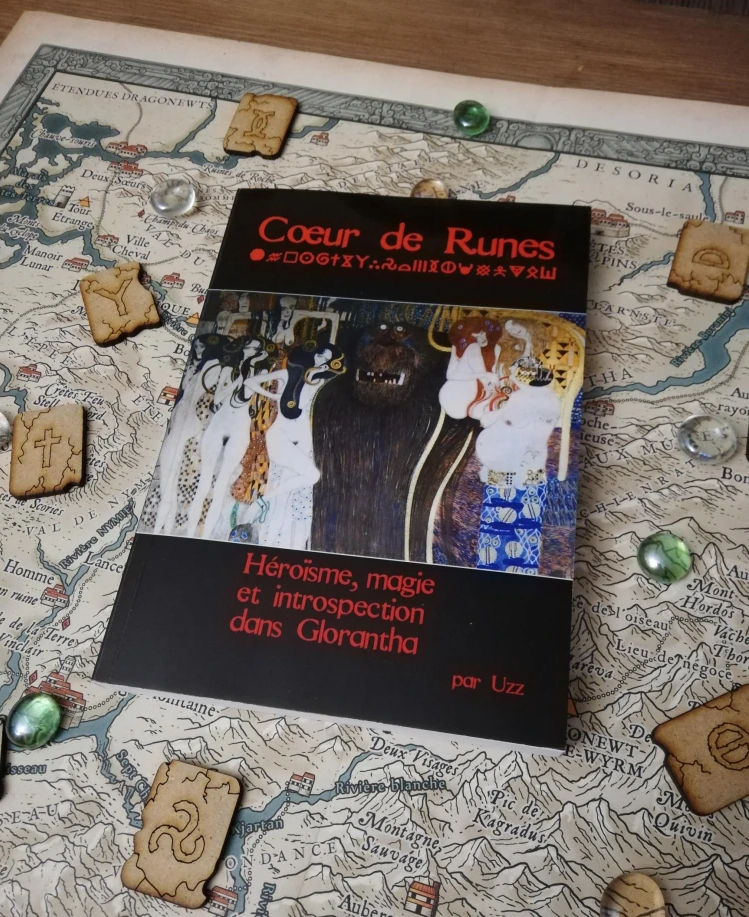
The previously mentioned French RPG “Coeur de Runes” has been updated to version 0.9.2 with a few tweaks, and the author has also provided separate files for the contents and the cover, for those who want to make their own print copy via Lulu.
If you’re good with French, you can also watch this interview of the author on the Vieux Geeks channel:
More Dragon Pass Tweeting
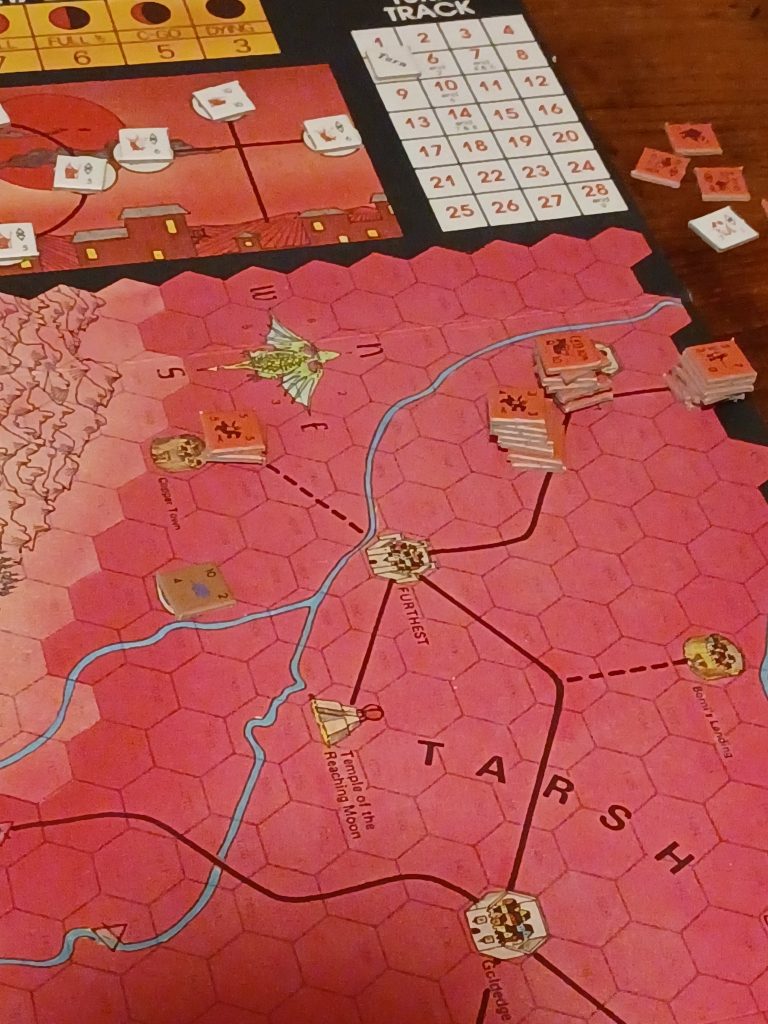
Effy continues her game of Dragon Pass (see last week’s Journal for the beginning), only with less fanfiction and more singing. Oh those poor Tarsh Exiles.
Creating a Grazelander Player Character

Runeblogger creates a Grazelander warrior called Tomiris, and you can follow along!
Below you can read how I followed the steps in the RuneQuest Roleplaying in Glorantha rulebook to create a player character. To avoid similarities with the pregenerated characters included in the core book and the Starter Set, I decided to create a Grazelander, since the Grazelands is one of the six homelands available for beginning characters. At the bottom of this post you can download the full character sheet of the PC I created, in case you would like to use it as a player character or non-player character in your campaign.
Fun With Memes
Over on Discord, Kelephant is having fun with crossing internet memes with Glorantha, something we haven’t done much here since our interview with Steinar!

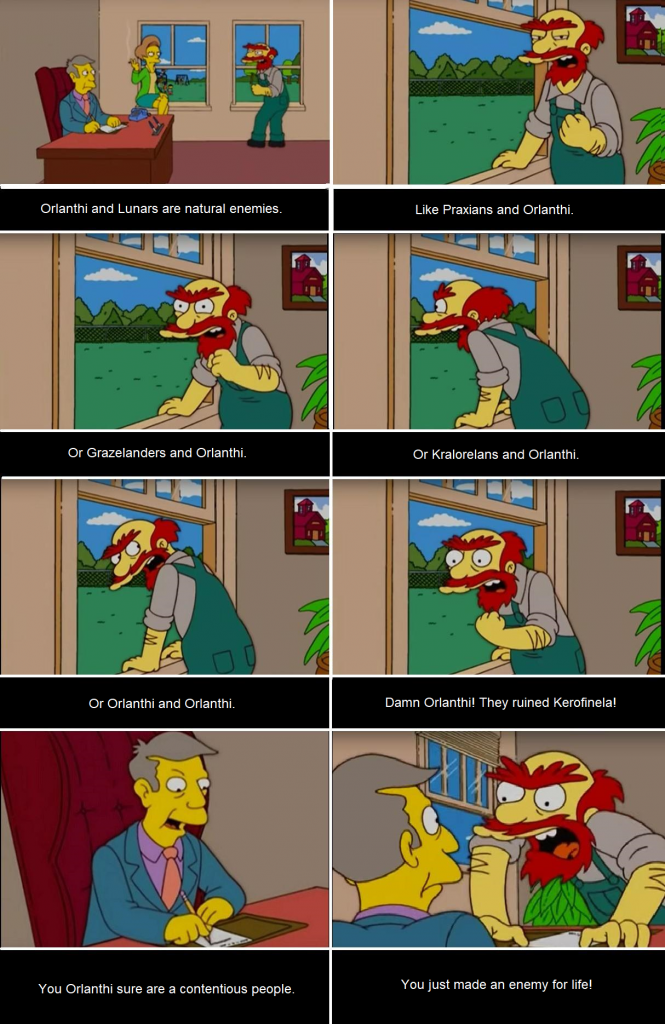
Elsewhere on Arachne Solara’s Web
Not everything is about Glorantha, although most things are! Here are loosely relevant things that we found on the interwebs.
Roman Purse
This is apparently a Roman purse, worn as an arm ring: you can’t pick-pocket the coins inside without removing the whole thing from the arm…. or the arm itself.
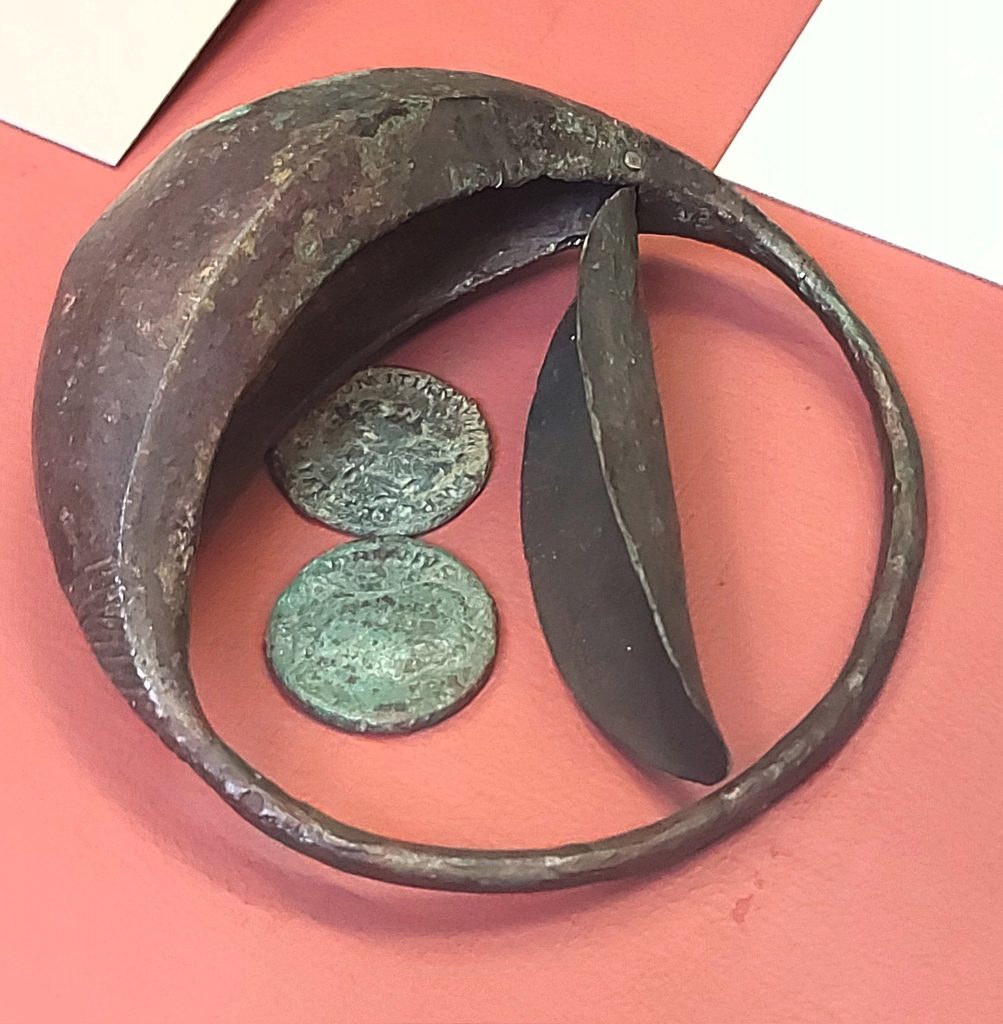
Put A Krasue in your Game
Do you want some creepy spirit for this week’s game? How about a woman’s head with a bunch of dangling organs beneath it, hovering around marshes at night?

This thing has a whole bunch of names, given it’s made its way through the folklore of a dozen Southeastern Asian cultures, but let’s go with the Thai name of “Krasue“.
Take your pick for what this spirit is about: maybe it’s a woman who got cursed for getting an abortion, maybe it’s a witch whose spells backfired on her, maybe you become that thing when one of these things infects you with their saliva, and so on. Sometimes they actually have a headless body left behind somewhere, which they need to protect.
I love this piece from Thai folklore:
It may attack cattle or chickens in the darkness, drinking their blood and eating their internal organs. It may also prey on pieces of cattle, such as water buffalo that have died of other causes during the night. If blood is not available the Krasue may eat feces or carrion. Clothes left outside would be found soiled with blood and excrement in the morning, allegedly after she had wiped her mouth. Therefore, villagers would not leave clothes hanging to dry outside during the night hours.
Because obviously, the most annoying thing about this absolutely terrifying thing is that it soils your fresh laundry! Oh the horror!
Noto Typeface
If you need to put some hieroglyphs or cuneiform somewhere, you could find them in this typeface from Google Font: Noto aims to have absolutely every character and pictograph known in the world!
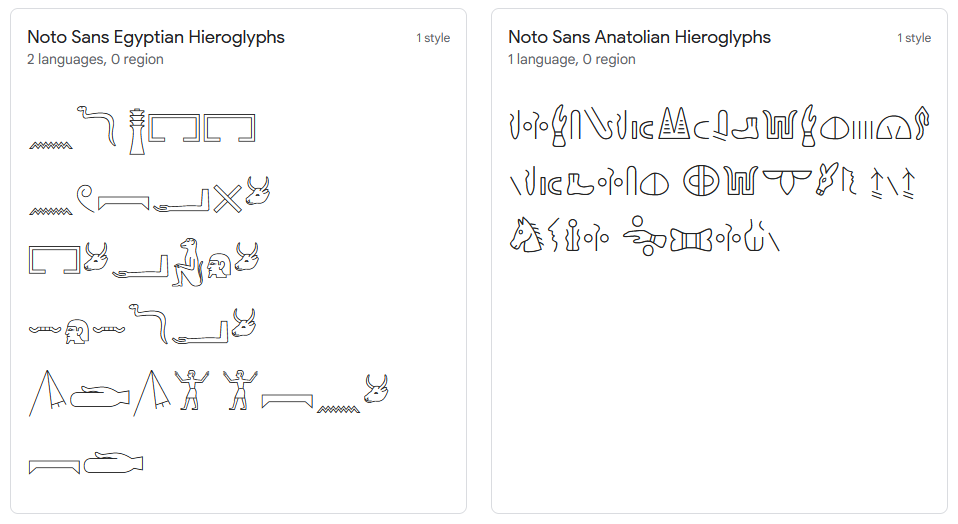
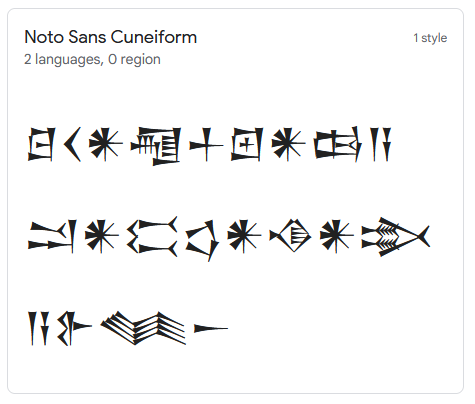
Thank you for reading
That’s it for this week! Please contact us with any feedback, question, or news item we’ve missed!



